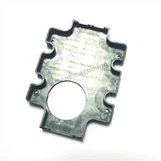Hey there! As a supplier of CNC Lathe Components, I often get asked this question: "Can I use CNC lathe components for multi - axis machining?" Well, let's dig into this topic and find out.
First off, let's understand what CNC lathe components are. CNC, which stands for Computer Numerical Control, lathes are machines that use computerized controls to perform various machining operations. The components of a CNC lathe include things like the spindle, chuck, turret, and tool holders. These parts work together to shape and cut materials, usually metals like aluminum and stainless steel. You can check out our Aluminium Turned Parts and Stainless Steel Turned Parts for some examples of what these components can produce.
Multi - axis machining, on the other hand, involves using a machine that can move the cutting tool or the workpiece along multiple axes simultaneously. This allows for more complex and precise machining operations. A typical multi - axis machine can move in three linear axes (X, Y, and Z) and sometimes additional rotational axes.
So, can you use CNC lathe components for multi - axis machining? The short answer is, it depends.
Compatibility of CNC Lathe Components
Some CNC lathe components can be adapted for multi - axis machining, but it's not a one - size - fits - all situation. For example, the spindle of a CNC lathe is designed to rotate the workpiece. In multi - axis machining, a similar rotation function might be needed, but the requirements could be different. In a multi - axis setup, the spindle may need to be more precise in its rotation speed and positioning, especially when working on complex geometries.
The chuck, which holds the workpiece in place on a CNC lathe, also plays a crucial role. In multi - axis machining, the chuck needs to be able to hold the workpiece securely during movements along multiple axes. If the chuck is not strong enough or does not have a good grip, the workpiece may move during machining, leading to inaccurate results.
The turret on a CNC lathe holds the cutting tools. In multi - axis machining, the turret may need to be more versatile. It should be able to quickly change tools as the machining operation progresses along different axes. Some advanced multi - axis machines have tool changers that can select the appropriate tool in a matter of seconds, which is a feature that a standard CNC lathe turret may not have.
Advantages of Using CNC Lathe Components in Multi - Axis Machining
If you can successfully adapt CNC lathe components for multi - axis machining, there are some significant advantages. One of the main benefits is cost - savings. Instead of investing in a brand - new multi - axis machine, you can use your existing CNC lathe components and make some modifications. This can be a more budget - friendly option, especially for small and medium - sized businesses.
Another advantage is familiarity. If your operators are already familiar with CNC lathe components, they can more easily learn how to use them in a multi - axis setup. This reduces the training time and potential errors that can occur when introducing a completely new machine.


Challenges of Using CNC Lathe Components in Multi - Axis Machining
However, there are also challenges. As mentioned earlier, the precision requirements in multi - axis machining are often higher. CNC lathe components may not be initially designed to meet these high - precision standards. For example, the linear motion systems in a CNC lathe may not be as accurate as those in a dedicated multi - axis machine. This can lead to issues such as poor surface finish and dimensional inaccuracies in the machined parts.
Software compatibility is another major challenge. CNC lathes typically use software that is optimized for their specific operations. Multi - axis machining requires more complex software that can control movements along multiple axes. You may need to upgrade or replace the existing software on your CNC lathe to make it suitable for multi - axis machining.
Making the Decision
When deciding whether to use CNC lathe components for multi - axis machining, you need to consider your specific machining requirements. If you only need to perform simple multi - axis operations and your CNC lathe components are relatively new and in good condition, it may be worth trying to adapt them. However, if you need to produce highly complex parts with tight tolerances, investing in a dedicated multi - axis machine might be a better option.
It's also important to consult with experts in the field. As a CNC Lathe Components supplier, we have a team of engineers who can provide advice on whether your components can be used for multi - axis machining. We can also help you with any modifications or upgrades that may be needed.
Conclusion
In conclusion, while it is possible to use CNC lathe components for multi - axis machining, it's not without its challenges. You need to carefully evaluate the compatibility of your components, the advantages and disadvantages, and your specific machining needs. If you're interested in exploring this option further, don't hesitate to reach out. We're here to help you make the best decision for your business. Whether you need advice on component adaptation or are looking to purchase high - quality CNC lathe components, we're your go - to source.
If you have any questions or would like to discuss your multi - axis machining requirements, feel free to get in touch. We're eager to start a conversation and see how we can assist you in achieving your machining goals.
References
- "CNC Machining Handbook" by John Doe
- "Multi - Axis Machining: Principles and Applications" by Jane Smith
- Industry reports on CNC machining trends and technologies




